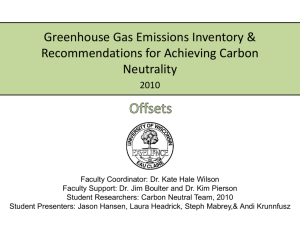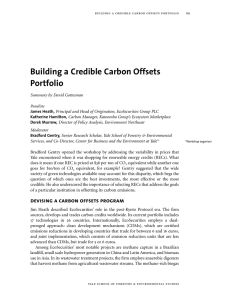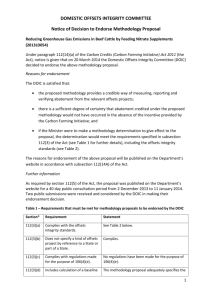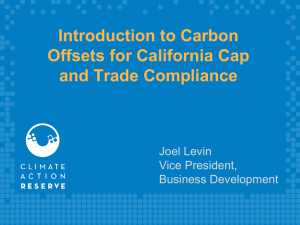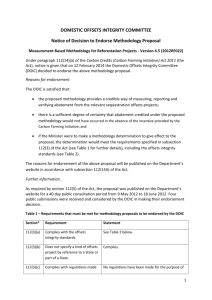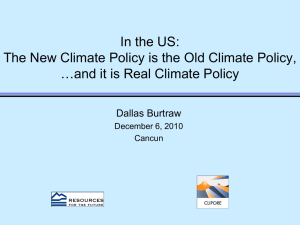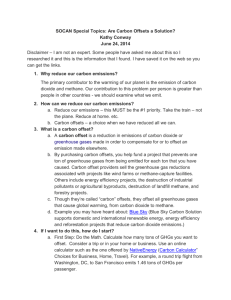2014 UM Campus Climate Conversation
advertisement
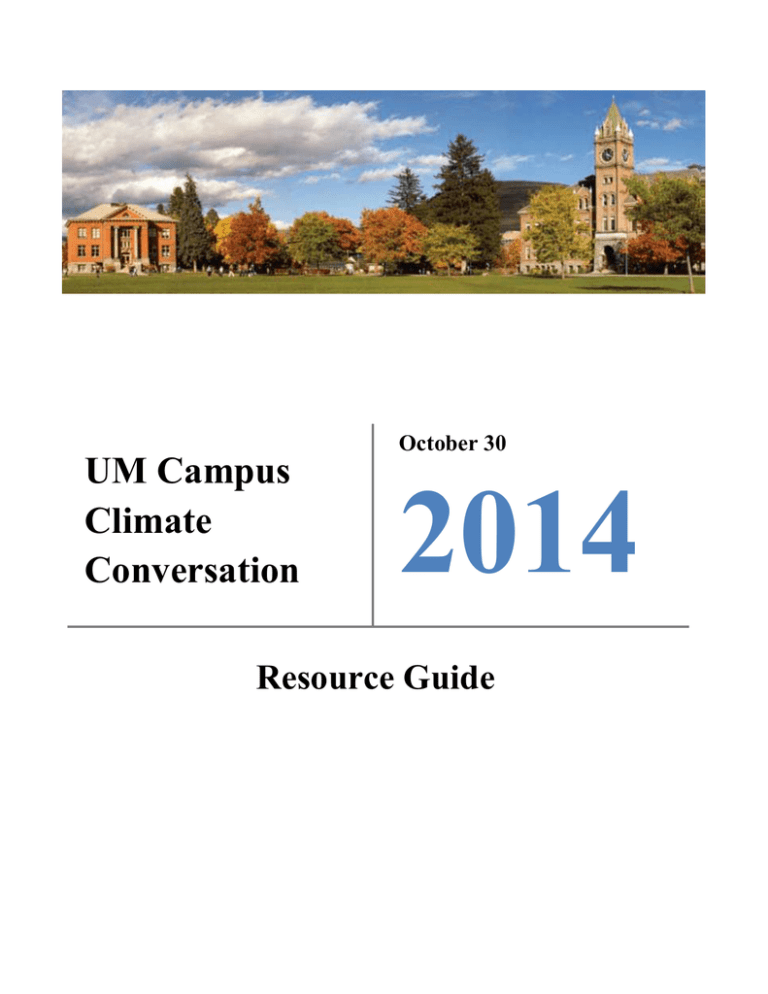
October 30 UM Campus Climate Conversation 2014 Resource Guide The University of Montana’s Campus Climate Conversations The University of Montana will host its third Campus Climate Conversation on Thursday, October 30th, bringing together students, faculty, staff, and administrators in discussion about how to advance our University’s Climate Action Plan. This event follows two previous Campus Climate Conversations, which focused on how to advance education, outreach, and decision-making to advance sustainability and UM’s Climate Action Plan. These campus conversations are based on an assumption that reaching our climate change goals will only be achieved through ongoing education and collaboration across campus. The Climate Action Plan is a multilateral project, not to be completed or achieved by one University entity, but rather through collaboration between students, faculty, and administration alike. While the University is actively pursuing energy efficiency and exploring the feasibility of large-scale solar and wind projects, there are parts of our campus carbon footprint, such as air travel, that cannot be addressed through energy efficiency or a transition to renewable energy. With a 2015 goal of carbon emissions reduction by 10% below 2007 levels quickly approaching, the prospect of the University purchasing carbon offsets is currently being considered. In fact, the only way to meet our near and longer term carbon reduction goals is to purchase carbon offsets. In order to determine how we move forward, input is needed on strategies for reaching our collective goals, including what types of carbon offsets to purchase, what criteria to use when selecting offsets, how our campus community prioritizes and pays for these offsets, and recommendations for new policies and practices. A Deliberative Process These Campus Climate Conversations are designed to be both educational and 'deliberative,’ meaning students, staff, and faculty will interact with one another in small groups to share views and ideas. Deliberation creates space that facilitates two-way forms of communication, or dialogue, where new ideas, synergies, and inspiration can be created that improve people’s ability to deal with complex challenges. The purpose is to enhance issues learning, collective action, and expanded problem-solving capacity. …”ideally deliberation is a means to identify problems and develop solutions through brainstorming and (perhaps) consensus decision making; the aim is the process, with solutions at most emergent. It promises production of widely acceptable solutions that probably were not on participants’ agendas before the deliberative exercise. As with collective action, deliberation can foster shared commitment and responsibility, creativity, confidence, and challenges to the status quo” (Johnson, 2012). Campus Conversation Goals The organizers for this event have generated three goals for the evening: 1) Educate our campus community about carbon offsets and possible projects. 2) Inspire ongoing engagement and collaboration across campus. 3) Decide what types of carbon offsets to purchase, how to prioritize, and generate recommendations for new policy and practices. 2 Part I: The University of Montana Climate Action Plan (CAP) In 2007, former University of Montana President George Dennison became one of the charter signatories of the American College and University Presidents’ Climate Commitment (ACUPCC). The ACUPCC strives to “accelerate progress through climate neutrality and sustainability by empowering the higher education sector to educate students, create solutions, and provide leadership-by-example for the rest of society.” Under ACUPCC, signing Colleges and Universities are required to address their institutional contribution to climate change and take active steps to first reduce and then eliminate their net greenhouse gas emissions. As a result of signing onto the ACUPCC, the University developed a Climate Action Plan (CAP) in 2010, which includes strategies and a Figure 1 timeline for reducing and eventually eliminating our institution’s greenhouse gas (GHG) emissions. The timeline includes two phases: an interim goal of 10% reduction in greenhouse gas emissions below 2007 levels by 2015 and complete carbon neutrality by 2020. An extensive GHG inventory was completed in 2008 in order to identify the scale of specific contributors on campus. UM has since conducted a comprehensive assessment every two years. Figure 1 shows UM’s total emissions in 2012.1 A third inventory will be completed by December 2014. Strategies for Achieving UM’s Climate Action Plan Goals UM’s GHG inventories have allowed us to understand in greater detail the many factors and operations associated with emissions on our University campus. Given that multiple departments, behaviors, operations, and budgets affect our emissions footprint, the 2010 Climate Action Plan identified a variety of strategies to meet its targets. Over the last several years, UM has invested substantially in energy conservation and saw a 1.7% reduction in GHG emissions between FY 2010 and 2012. Accomplishments toward our CAP are noted in UM’s 2013 and 2014 State of Sustainability Report Cards. The Montana University System Board of Regents approved the Smart Buildings Initiative (SBI), a resolution developed in 2013/14 by students at UM and MSU that allows the savings incurred from energy efficiency projects to be reinvested in more efficiency projects. This new accounting system is still being implemented at UM. Strategies for further emissions reductions are identified in the 2010 Climate Action Plan. In order to increase energy efficiency and bolster energy conservation, strategies include retrofitting campus buildings to improve energy efficiency and reducing building energy consumption over school breaks. Behavior 1 Emissions inventory as of December 2012, compiled by Cherie Peacock. 3 modification, which is characterized by the use of education and social marketing in order to promote sustainable personal behavior on campus, is also identified in the CAP report as a potentially useful tool for energy conservation and efficiency. An additional strategy for meeting the University’s emission reduction goals is through investments in renewable energy projects both on and off campus. The University has explored a variety of off-campus renewable energy generation opportunities in the last two years and continues to research the feasibility and cost associated with large-scale solar and wind projects. Based upon what we know of our emissions footprint, some combination of renewable energy generation projects will be necessary for UM to achieve its carbon neutrality goal. Another strategy identified in the CAP report is to improve the efficiency of transportation services associated with the University. Transportation accounted for 31.6% of the total 2007 University of Montana emissions and continues to account for approximately one third of UM’s emissions. Figure 2 shows the percentage of carbon emissions by each transportation method used by the UM population. Increasing the accessibility and energy efficiency of our bus system, and reducing the frequency of single-occupancy vehicle commuting to campus, could significantly reduce the University’s GHG emissions through the transportation sector. Figure 2 The purchasing of carbon offsets is another strategy defined by the CAP report to specifically address aspects of the University’s carbon footprint that cannot be eliminated through energy efficiency projects or renewable energy investments. The best example would be the University’s GHG emissions through faculty, student, and administrative air travel. As shown in Figure 2, air travel accounts for nearly half of University travel-related emissions. In order to reach carbon neutrality by 2020, the purchase of carbon offsets is necessary to offset the University of Montana’s air travel emissions. Achieving carbon neutrality by 2020 will require active participation by the entire University community and the utilization of the variety of reduction strategies outlined in the CAP report, including financial investments in renewable energy and energy efficiency programs, carbon offset purchasing, and sustainable behavior modification. Reaching our interim emissions reduction goal is possible with the purchase carbon offsets. In doing so, the University can capitalize on this success and build momentum toward achieving carbon neutrality by 2020. The remainder of this reference guide will examine carbon offsets as a strategy for UM to consider as we address our upcoming deadlines and future emissions targets. 4 Part II: Carbon Offset Purchasing at The University of Montana UMCOIN Report Since the implementation of the Climate Action Plan, several student initiatives have sought to address the University’s unavoidable emissions (such as air travel, which accounted for 13% of 2007 emission levels) through carbon offset purchasing. A project completed in 2013 titled, University of Montana Air Travel Carbon Offset Use (UMCOIN), identified how the purchasing of carbon offsets might be implemented at the University of Montana. By providing local, regional, and global examples, the UMCOIN report examined how other Universities and institutions have successfully used carbon offsets in their own Climate Action Plans. Figure 3 One component of the UMCOIN report is a survey that students conducted to measure faculty support for a voluntary carbon offset program at the University of Montana. The survey was completed by 28 department chairs and allowed the students conducting the survey to gain a better understanding of how carbon offsets are viewed by faculty members, as well as the level of support for different carbon offset projects. Taken from the UMCOIN report, Figure 4 illustrates different types of carbon offset projects and the percentage of responding department chairs who supported these types of projects. The top three preferred projects were renewable energy (75%), energy efficiency (67.86%), and forest management (60.71%). Additionally, the survey asked department chairs which factors were most important in the selection Figure 4 of carbon offsets. Figure 5 (next page) identifies several purchasing criteria and their importance to survey participants. The three most important factors to consider when purchasing carbon offsets were proximity (69.23%), cost (69.23%), and third party certification (65.38%). 5 The UMCOIN survey asked department chairs about their interest in participating in both voluntary and mandatory carbon offset programs. A majority (68%) supported or strongly supported a voluntary program, while only 7% opposed it. In contrast, 43% would support or strongly support a mandatory program while 25% would oppose or strongly oppose it. 74% would be willing to pay a $12 flat offset fee for domestic flights, and roughly 60% would be willing to pay a $35 flat offset fee for international flights. Figure 5 The UMCOIN report presented four primary recommendations for a carbon offset program at the UM. First, education and outreach needs to be increased for students, faculty, and staff in order to increase awareness and understanding of carbon offsets. Second, a voluntary program for air travel should be implemented, and departments should be empowered to participate. Third, mileage for air travel should be tracked by department to ensure accurate figures and reporting. (Currently, mileage is not tracked, only the total cost of air travel is reported, from which mileage estimates are calculated.) Fourth, the implementation of flight caps for air travel should also be explored in order to further reduce the GHG emissions of air travel. While the UMCOIN report provided insight into what some department chairs think about carbon offset purchases, there is still a void in data that examines student, faculty, staff, and administrators’ attitudes toward carbon offsets. The 2014 Campus Conversation will be an opportunity to learn, discuss, and decide on how we address the purchasing of carbon offsets in order to meet the 2015 interim goal. The Current Status of Offset Procurement Since the beginning of 2014, students, with support from the ASUM Sustainability Coordinator and Sustainable Campus Committee, have worked to identify funds from across the University for the purchase of carbon offsets. In March, $5,600 was granted by the KRELF (Kless Revolving Energy Loan Fund), which represented a significant student contribution to offset purchasing through the sustainability fee. Throughout the year, a variety of academic and non-academic departments have contributed funds for a combined additional $1,900 for offset purchasing. Efforts are currently underway to secure additional funds through academic and non-academic departmental donations. It’s expected to cost approximately $20,000 to reach our interim carbon reduction goal. The importance of meeting the 2015 interim emissions reduction goal through carbon offset purchasing is both a practical and symbolic matter. By taking responsibility to meet this goal, the University demonstrates its commitment to reduce its contribution to climate change. Successfully meeting our 2015 interim goal via offsets and energy conservation will enable us to look toward our bigger, more ambitious 2020 carbon neutrality goal with a positive outlook, renewed commitment, and a well-earned sense of progress. 6 Part III: Carbon Offsets and Renewable Energy Credits Carbon Offsets One carbon offset represents a reduction or removal of one metric ton of carbon dioxide equivalent (CO2e) that is then used to counterbalance or compensate for greenhouse gas emissions elsewhere. Carbon offsets can be generated through any project activity (e.g., renewable energy, energy efficiency, methane destruction, or reforestation projects) that either sequesters atmospheric carbon dioxide or reduces the amount of GHG emissions into the atmosphere beyond what would have happened in the absence of the project. While carbon offsets should not be the only strategy utilized by a university, the American College and University Presidents’ Climate Commitment (ACUPCC) recognizes that institutional carbon neutrality cannot be achieved without supplemental investment in carbon offset projects. Universities can utilize carbon offsets in a variety of ways. They may develop offset projects themselves, invest directly in other offset projects, or purchase credits generated by offset projects of other organizations. Other colleges that have instituted carbon offset programs include Duke University and University of British Columbia. Duke’s program utilizes community-based projects for energy efficiency retrofits and a local swine farm methane capture project. The University of British Columbia is required by legislation to purchase carbon offsets, greatly incentivizing efforts to address other areas of their CAP such as fleet and building upgrades. The ACPUCC defines specific criteria for legitimizing the use of carbon offsets as a part of a climate action plan as follows. Carbon offsets must be: 1. Transparent: All project details are provided. 2. Real: Offsets result in net reduction of emissions and do not come about by way of some accounting adjustment. 3. Additional: Project passes tests showing it is legitimately a result of offset purchases. 4. Measurable: Can the amount of carbon dioxide offset by project be quantified? 5. Permanent: Is the reduction irreversible? 6. Valid and Verifiable: Have projects been evaluated by an outside party? 7. Synchronous: Is the timing of the reduction appropriate? 8. Account for Leakage: Have potential inadvertent emissions increases elsewhere been accounted for? For example, if a sector of forest is preserved, does that push logging or firewood gathering into other unprotected areas? 9. Include Co-Benefits: Does the project have other social, environmental and economic benefits? 10. Enforceable: Are the offset investments backed up by a contract? As an example, if a forestry project burns down, is there some recourse to vouch safe the expected offsets? 11. Registered: Is the reduction counted only once and custody transfer adequately tracked? 12. Double Counting: Is the reduction claimed by one entity only? For example, an energy efficiency project by a city will unload a power plant. The city legitimately takes credit for the offsets 7 produced, but perhaps the power plant has also performed some energy efficiency measures and takes credit for power reductions due to both its efficiency work and that of the city. 13. Retired: Have the credits been pulled out of the market? Examples of local options for non-certified carbon offsets There are a number of small-scale local Montana offset projects. Current discussions of projects include ecological restoration efforts at the Clark Fork Coalition’s Dry Cottonwood Creek Ranch in the Deer Lodge Valley; reforestation on Salish-Kootenai tribal lands; Northwestern Energy proposal applicants such as Rocky Mountain Elk Foundation easement purchase and restoration; Montana Trout Unlimited stream-side easement purchase and restoration; and low income housing energy retrofits central to Mayor Engen’s campaign promises. The University also has the ability to develop offset projects with its 28,000 acre Lubrecht Experimental Forest and the 3,436 acre Bandy Experimental Ranch. These projects are not certified at this time. The University can assist local projects in obtaining reputable certification financially and/or technologically and claim the carbon offset in return. Another viable choice for a completely local option is the methane capture project at Huls Dairy, located in the Bitterroot Valley. Huls Dairy methane capture system utilizes 30,000 gallon tanks to anaerobically process manure sludge. During this process, methane gas is produced and captured at a rate of 20 cubic feet per minute, 24 hours a day. The captured gas is used to fuel a net-metered 50 kilowatt generator. The remaining fibers—now with harmful pathogens destroyed—can be sold as bedding and fertilizer. The methane capture system has been in disuse for several years. Currently, Huls is looking to restart their methane capture facility. This project serves as an example of a potential local offset opportunity, but is not immediately an option for offsetting our emissions. Renewable Energy Credits Renewable Energy Credits (RECs) are tradable, non-tangible energy commodities that represent proof that one megawatt-hour (MWhr) of electricity was generated from an eligible renewable energy resource. In order to meet ACUPCC requirements, RECs must be replacing “brown” electrons on the grid, not just adding new green energy to the system. RECs are sometimes treated as carbon offsets, although the concepts are not interchangeable. Whereas a carbon offset represents a reduction in greenhouse gas emissions, a REC represents a quantity of energy produced from renewable resources. To convert RECs into offsets, the clean energy must be translated into carbon reductions, typically by assuming that the clean energy is displacing an equivalent amount of conventionally produced energy from the grid. This is considered an indirect offset because the reduction doesn’t take place at the project site itself, but rather at an external site. 8 Part IV: Now What? In order to determine how close we are to our 2015 interim goal, we need to know what our emissions have been for FY 2013 and FY 2014. UM’s Sustainability Coordinator, Eva Rocke, is currently collecting the data for our most recent GHG inventory, which is due to the ACUPCC and Second Nature on January 15, 2015. Technically, this is also the date by which UM should aim to have met its 2015 interim reduction goal. The October 30, 2014 Campus Climate Conversation is an effort to engage our campus community in a discussion about the role of carbon offsets and RECs in our achievement of carbon neutrality. UM has purchased offsets and RECs in the past, including Renewable Energy Credits from Sterling Planet and from the City of Missoula (Green Tags), but it does not currently have an official carbon offset purchasing policy or a budgeting mechanism for offsets. However, our commitment to carbon neutrality implies that we are also committed to addressing the portions of our emissions that cannot be eliminated through conservation, behavior modification, and renewable energy generation. This conversation is an opportunity to share your thoughts and creative solutions to the complex challenge of UM’s emissions reduction goals, knowing that we are a university that values conducting research abroad, study abroad opportunities for our students, UM’s representation at national and international conferences, and the recruitment of the most qualified faculty and talented athletes. Knowing that UM will always be responsible for some emissions that cannot be addressed through energy efficiency, conservation, and renewable energy generation, how should we move forward with our carbon neutrality commitment? What responsibility do we have, as a community, to offset our emissions while being an internationally engaged academic institution? To help us engage productively in these discussions, consider the following questions: 1) 2) 3) What criteria should be prioritized in the purchase carbon offsets or Renewable Energy Credits (RECs)? Consider: Local/regional or international projects, type, cost, if certified. How should offsets be paid for in the future? Where should funding come from? Who should pay for these emissions reductions and by what mechanism? Consider: Centrally by administration, by Departments, by Colleges, by students or faculty who travel using fossil fuels? What are key pieces of a new carbon offset policy? Consider how to integrate carbon accounting and offset project evaluation into our curriculum, research, and University procedures. Thank you for considering these topics and questions! Your thoughts and ideas are important to making these goals a reality. Thank you also to the UM students who contributed to the UMCOIN report (Chris Olsen, Michaela Finnegan, and Alia Mulder), and to the students in Robin Saha’s Environmental Citizenship class who gathered funds to help us meet our 2015 goal, and who sparked a conversation among University leaders to initiate further education and movement on this issue (Charles O’Bosky, Crystal Whitmore, Zachary Bauerle, Kaya Juda-Nelson, & James Lyon). Thanks also to Zachary Bauerle and Chris Olsen for their work on this report. UM students continue to fuel our campus movement on this important issue. 9 AGENDA Thursday, October 30, 2014 5:30 pm - 8:00 pm University Center, Rooms 332/333 5:20 Participants arrive, register, and go to assigned table Complete pre-deliberation survey 5:30 Welcome by UM President Royce Engstrom 5:35 Review of Evening’s Goals & Activities & Introduction of Panelists 5:40 Background presentations by Resource Panel Brian Kerns – Carbon offsets and RECs and their role in our CAP Molly White – What to consider when choosing offsets Kara Colovich – Examples from other colleges/universities Steve Schwarze – Why we are having this conversation 6:20 Small group discussions with moderators around focused questions Question #1: What criteria should be prioritized in the purchase carbon offsets? Question #2: How should offsets be paid for in the future? Question #3: What are key pieces of a new carbon offset policy? Refreshment break by table 7:00 Q&A with Panelists and Participants 7:15 Small group discussions with moderators continue 7:35 Report out from small groups Each table presents a synthesis of the big ideas from their table 7:50 Closing Remarks and Next Steps Complete post-deliberation survey 8:00 Departure The Organizing Committee thanks you for your participation! Eva Rocke, UM Sustainability Coordinator (staff) Nicky Phear, Climate Change Studies Program Coordinator (faculty) Chris Olsen, ASUM Sustainability Coordinator (student/staff) Kara Colovich, UM Climate Action Now President (student) Zach Bauerle (student) 10

